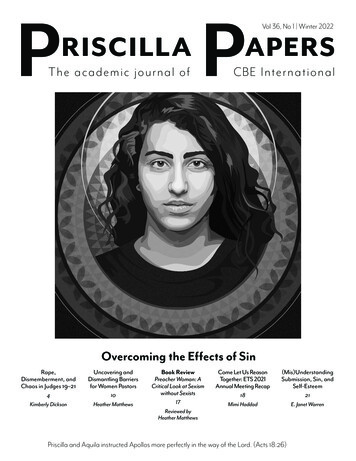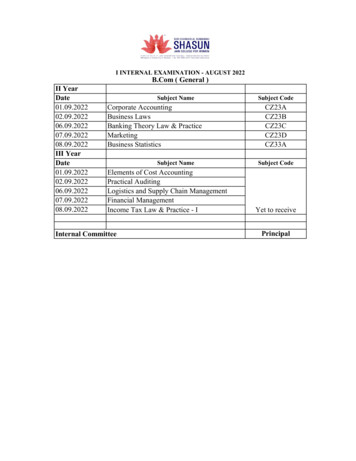
Transcription
P The academic journal ofP Vol 36, No 1 Winter 2022CBE InternationalOvercoming the Effects of SinRape,Dismemberment, andChaos in Judges 19–21Uncovering andDismantling Barriersfor Women Pastors4Kimberly Dickson10Heather MatthewsBook ReviewPreacher Woman: ACritical Look at Sexismwithout Sexists17Reviewed byHeather MatthewsCome Let Us ReasonTogether: ETS 2021Annual Meeting Recap(Mis)UnderstandingSubmission, Sin, andSelf-Esteem18Mimi Haddad21E. Janet WarrenPriscilla and Aquila instructed Apollos more perfectly in the way of the Lord. (Acts 18:26)
I Tertius . . .Cara Quinn created and graciously provided theartwork displayed on the cover of this issue ofPriscilla Papers. Cara runs Know Your Mothers,a project seeking to empower women in thechurch by uncovering buried stories of womenfrom the past (see https://knowyourmothers.com and @Knowyourmothers on Instagram).Cara also created the artwork for the fall 2020 cover of CBE’sMutuality magazine and wrote the article, “Six Black FemaleArtists Christians Should Know,” in that same issue y-blog-magazine/print-archives).The cover art is titled, “The Levite’s Concubine.” In the contextof Know Your Mothers, it accompanies “Take My Story to Heart:Thoughts from the Levite’s Concubine in Judges 19,” a creativewriting piece by Kimberly Dickson. Kim also wrote the openingarticle in this issue of Priscilla Papers, “Rape, Dismemberment,and Chaos in Judges 19–21.”When I became editor of Priscilla Papers, I knew I would beworking with many articles about what could be called the corebiblical texts, those texts over which complementarian/egalitariandebates are commonly held: Genesis 1–3, Deborah in Judges 4–5,Song of Songs, 1 Corinthians 11 and 14, Galatians 3:28, Ephesians5, 1 Timothy 2, etc. And I knew, of course, that I would encounterother texts and themes as well.What I did not expect, however, was how frequently articlessubmitted to Priscilla Papers would grapple with “texts of terror,”to borrow a now-common phrase from Phyllis Trible’s 1984 book,Texts of Terror: Literary Feminist Readings of Biblical Narratives.Nevertheless, the first issue I worked on (fall 2014) includedpieces on Jephthah’s daughter and on Tamar of 2 Samuel (byRollin Ramsaran and Deirdre Brouer, respectively). In that sameissue, we reviewed Philip Esler’s book, Sex, Wives, and Warriors(Cascade, 2011), which includes chapters on Bathsheba, bothTamars (Gen 38 and 2 Sam 13), and other alarming texts. Overthe years, the horrors of Judges 19 keep coming up, again (“ANegative Model of Manhood in Judges 19” by Craig Keener, spring1995), and again (“The Levite’s Concubine: Domestic Violenceand the People of God” by Elaine Heath, winter 1999), andagain (“Voices of Outrage against Rape: Textual Evidence fromJudges 19” by Deirdre Brouer, winter 2014), and again (“Judges19 as a Paradigm for Understanding and Responding to HumanTrafficking” by Chuck Pitts, fall 2015), and again (“He Made HerPlay the Harlot: Judges 19 through the Lens of Domestic Abuse”by Evelyn Sweerts-Vermeulen, summer 2021), and still again inthe present issue.In hindsight, though I did not anticipate encountering just asmany articles like these as I do articles addressing so-called coretexts, I am not surprised. It seems that sin still prowls the worldlike a roaring, devouring lion (cf. 1 Pet 5:8)—hence the theme ofthis issue, “Overcoming the Effects of Sin.”This editorial will continue onto a second page in order to makeyou aware of some developments in gender-accurate Bible translation.N. T. Wright, The New Testament for EveryoneFirst, I was pleased to discover that N. T. Wright’s translation ofthe NT is now freely available at BibleGateway.com, as The NewTestament for Everyone (NTE). Wright’s translation is not new. It waspublished in 2011 as The Kingdom New Testament: A Contemporarycontinued on next pageDISCLAIMER: Final selection of all material published by CBE International in Priscilla Papers is entirely up to the discretion of the publisher, editor, and peer reviewers.Please note that each author is solely legally responsible for the content and the accuracy of facts, citations, references, and quotations rendered and properly attributedin the article appearing under his or her name. Neither CBE, nor the editor, nor the editorial team is responsible or legally liable for any content or any statements madeby any author, but the legal responsibility is solely that author’s once an article appears in print in Priscilla Papers.Editor: Jeff MillerAssociate Editor / Graphic Designer: Theresa GarbePresident / Publisher: Mimi HaddadPresident Emerita: Catherine Clark Kroeger†Consulting Editor: William David SpencerPeer Review Team: Katrina Armas, Joshua Barron, Lynn H.Cohick, Havilah Dharamraj, Tim Foster, Nijay Gupta, SusanHowell, Jamin Hübner, Loretta Hunnicutt, Kyong-Jin Lee, EsauMcCaulley, Adam Omelianchuk, Chuck Pitts, Angela RavinAnderson, Marion Taylor, Karen Strand WinslowOn the Cover: The Levite's Concubine, by Cara Quinn knowyourmothers.com. Used with permission.Priscilla Papers is indexed in the ATLA Religion Database (ATLA RDB ),http://www.atla.com, in the Christian Periodical Index (CPI), in NewTestament Abstracts (NTA), and in Religious and Theological Abstracts(R&TA), as well as by CBE itself. Priscilla Papers is licensed with EBSCO’s fulltext informational library products. Full-text collections of Priscilla Papers areavailable through EBSCO Host’s Religion and Philosophy Collection, GalaxieSoftware’s Theological Journals collection, and Logos Bible Software. PriscillaPapers is a member publication of the American Association of Publishers.2 PRISCILLA PAPERS 36/1 Winter 2022Priscilla Papers (issn 0898–753x) is published quarterly byCBE International122 W Franklin Avenue, Suite 218, Minneapolis, MN 55404–2451www.cbeinternational.org 612–872–6898 CBE International, 2022.cbeinternational.org
Translation, and before then it became available in incrementsas part of the “For Everyone” commentary series (Matthew forEveryone, Mark for Everyone, etc.). Wright’s main purpose wasnot to create a gender-accurate translation. Nevertheless, certainfeatures of his translation will tend to be viewed positively byegalitarian readers. These include, for example: Wright’s choice not to separate Ephesians 5:21 and5:22 with a subheading. Wright’s translation of 1 Timothy 2:11–12: “Theymust study undisturbed, in full submission to God.I’m not saying that women should teach men, or tryto dictate to them; rather, that they should be leftundisturbed.” Wright’s use of “brothers and sisters,” or otherexpressions, instead of “brothers.”Translations within commentaries are helpful because thetranslator has ample space to explain her or his choices. In thiscase, Wright’s translation has been removed from its originalcontext (a commentary series), and as a result some texts have losttheir clarity. For example, Wright translates Romans 16:7 as “GreetAndronicus and Junia, my relatives and fellow prisoners, who arewell known among the apostles. . . .” His wording, “well knownamong the apostles,” could be viewed as a compromise betweenthe competing options, “outstanding among the apostles” (NIV)and “well known to the apostles” (ESV). But his commentaryclarifies, “the phrase ‘well known among the apostles’ doesn’tmean that the apostles knew her and Andronicus . . . but that theyare apostles. . . . She has the same status as all the other apostles,including Paul himself ” (Paul for Everyone: Romans [WestminsterJohn Knox, 2004] 134).NRSV Updated EditionThe New Revised Standard Version Updated Edition (NRSVue) isa revision of the 1989 NRSV. The National Council of Churchesof Christ in the U.S.A. holds the copyright. It is currently availablefor purchase in digital format from Friendship Press and theWord@Hand app; print editions are anticipated later in 2022.Though the NRSV made significant progress toward genderaccurate Bible translation, it also left much to be desired foregalitarian readers—to a certain degree in 1989 and even morein hindsight. You can expect a fuller review of the NRSVue whenprint and searchable online editions are available, but for now, twoexamples (drawn from friendshippress.org) will provide someoptimism to readers of Priscilla Papers.Matthew 2:1NRSV: “In the time of King Herod, after Jesus was bornin Bethlehem of Judea, wise men* from the East cameto Jerusalem,”*Or astrologers; Gk magiNRSVue: “In the time of King Herod, after Jesus wasborn in Bethlehem of Judea, magi* from the east cameto Jerusalem,”*Or astrologerscbeinternational.orgGalatians 1:11NRSV: “For I want you to know, brothers and sisters,*that the gospel that was proclaimed by me is not ofhuman origin;”*Gk brothersNRSVue: “For I want you to know, brothers and sisters,that the gospel that was proclaimed by me is not ofhuman origin.”In the Galatians example above, the wording of the NRSV andNRSVue is identical. The difference is that the later edition lacksa footnote. The 1989 footnote implies that “brothers and sisters”is an expanded, adapted, non-literal translation of the Greekword for “brothers” (adelphoi, singular adelphos). Removing thefootnote was a good decision, and the website rightly explains,“adelphos is not intrinsically gender-exclusive” (NRSV UpdatedEdition: Bible Sampler, xxii). To try to adopt the point of viewof first-century Christians may help us think clearly about this.When such Christians heard, for example, one of Paul’s lettersread aloud in a house church, and the letter addressed them asadelphoi, the women and men in the group did not hear this worddifferently. It is not the case that the men heard it directly andliterally (“adelphoi refers to us men”) while the women heard itindirectly and metaphorically (“adelphoi refers to those men, butit can also connote us women”).Surprising StepsThe summer 2021 issue of Priscilla Papers included a review ofthe 2020 revision of the Christian Standard Bible (CSB) titled,“Surprising Steps in the Right Direction.” The review identifieda modest trend among complementarian Bible translators towardcertain egalitarian translation choices. The review noted, forexample, that the 2020 revision of the CSB changed “fathers”to “ancestors” over 200 times. Going back a step, the first CSB(2017) was a revision of the Holman Christian Standard Bible(HCSB), first published in 1999. The 2017 CSB moved away fromits predecessor, the HCSB, and used “brothers and sisters” totranslate adelphoi about 175 times.Shifting to a different translation, I am pleased to report thatthe 2020 revision of the New American Standard Bible (NASB, The Lockman Foundation) translates adelphoi as “brothers andsisters” (or adelphos as “brother or sister”) about 150 times. CBEInternational does not endorse the NASB, and Priscilla Papers willnot be publishing a fuller review of it. Nevertheless, its treatmentof adelphoi is significant as further evidence for the trend notedabove, especially since the NASB is widely assumed to be the mostliteral English Bible (though neither the NASB translators nor theLockman Foundation would make such a vague claim).CBE continues to recommend gender-accurate Bible translationssuch as the Common English Bible (CEB), the 2011 NIV, and theNRSV/NRSVue. If patriarchy and androcentrism are results of sin,and if such translations work against patriarchy and androcentrism,then perhaps we can say they are part of overcoming the effects ofsin—the theme of this issue of Priscilla Papers. . . greet you in the Lord.PRISCILLA PAPERS 36/1 Winter 2022 3
Rape, Dismemberment, and Chaos in Judges 19–21Kimberly DicksonThe unifying theme of Judges 19–21 is the dismal failure ofIsrael to care for their most vulnerable, ultimately contributingto the demise of the nation. This theme is the culmination of twodifferent agendas within the story. The first and more obviousis the backstory of a devastating civil war due to the collapseof hospitality, a value central to Israel’s national identity. Thesecond is an illustration of Israel’s moral degeneracy that couldonly be reversed (or so they thought) through a new form ofgovernment, a monarchy. Like concern for the “least of these”shrouded in Israel’s hospitality rules, Israel’s moral collapse issymbolized in its degenerate treatment of women, both throughan individual and the broader group she represents.1Structure and PlacementStructure and ThemesThe overarching structure divides this tale into three parts.Chapter 19 provides the backstory with what could be termeda “human interest story” that culminates in a Levite callingthe tribes together to incite civil war. Chapter 20 describesthe tribes’ rationale for civil war andthe battles that lead to its militaryoutcome. Chapter 21 wrestles withthe future of the tribe of Benjamin,as Israel seeks to provide wivesfor the tribe’s remaining warriors.Embedded within this structureare recurring ideas that drive thetheme of the story. These four ideas are: “the heart”; hospitalitymanipulated, denied, and abused; sexual abuse and outrage;and the destruction of women.Judges 19–21 is a grim ironic narrative.2 Intentionallycontrasting with Lot’s guests in Sodom in Gen 19, Judges 19 usesthe same plot but reshapes it so the reader recognizes the irony.3Features common to the two stories include sojourners seekinghospitality, being taken in by another foreigner, a mob seekingto sexually assault the guests, a host seeking to protect hisguests using the same words to the townsfolk, and girls offeredin the place of the men. The differences between the stories arewhere the gruesome irony becomes apparent.4 One set of God’srepresentatives arrive immersed in prayer to protect whilethe other comes as a pimp; one protects the weakest while theother thrusts the weakest out to protect himself; one physicallygrabs the family to take them to safety while the other grabs thedevastated to take her to dismember.5The irony continues beyond the Genesis/Sodom and Judges/Gibeah parallel. The story revolves around terminology of“the heart.” The Levite intends to persuade the girl to returnby “speaking to her heart.” Instead, he makes his own “heartmerry” with his father-in-law and with the host in Gibeah.Likewise, the tribes of Israel advise one another to “set theirheart” on the dismembered girl as they consider their actions.Instead, by the close of Judges 21, the women of Israel have been“dismembered” like the concubine.6The lament that surrounds the story solidifies the grimirony: “In those days there was no king in Israel; all the peopledid what was right in their own eyes” (NRSV). What was rightin their own eyes was evil in the eyes of God and all others.The book of Judges begins with the accounts of morallyupright and good leaders, only to progressively descend until itreaches its most ignoble conclusion with the final two stories atthe close of the book, Judges 17–18 and Judges 19–21.7 Togetherthey demonstrate the revolting depravity into which the nationhad fallen without a king, as the stories are uniquely surroundedby and even interrupted by the saying, “In those days there wasno king in Israel; all the people did what was right in their owneyes” (NRSV).Each of these two stories is centered on the actions of a Levitewho is meant to serve as an intermediary with God but, instead,is wholly inept and unqualified to lead the people. In Judges17–18, not only is the Levite tainted by idol worship, but healso lacks the leadership clout to stopthe Danite tribe from annihilating a“quiet and trusting people” (18:27).At sword point his courage fails himand he acquiesces to their genocide.The final Levite ups the ante, actuallyinstigating civil war. Again, ironyseeps through these stories as Levites,who were never meant to be a warrior tribe, are central to theseunholy wars.8“In those days there was no king inIsrael; all the people did what wasright in their own eyes” (Judges21:25 NRSV).4 PRISCILLA PAPERS 36/1 Winter 2022Canon Position and Its SignificanceThe Jewish and Christian canons position Judges differently,revealing emphases in their traditions. The Jewish canonjuxtaposes Israel’s abysmal leadership and abuse of women inJudges with the book of Samuel. Directly following the demiseof women in Judges, Eli summarizes how great a sin YHWHconsidered sexual abuse against women in his warning againsthis own sons. He states that their sexual use of women servingat the tent of meeting is worse than sinning against men (1 Sam2:22–25). Instead, this type of abuse incites the judgment ofYHWH (1 Sam 2:27–36). True to Eli’s word, YHWH removesleadership from Eli’s descendants and through Samuel transfersthe leadership to a monarchy.Alternatively, the Christian canon reacts to the violatedhospitality, which destroyed rather than protected the weakestof society, by placing the story of Ruth and Naomi directlyafter Judges.9 This canonical placement highlights that both theconcubine and also Naomi and Ruth return to Bethlehem indistress. But instead of Bethlehem failing to protect a vulnerablegirl, the defeated widow and powerless foreign daughter-in-laware honored and protected, and they flourish. Hospitality fulfillsits role of protecting the weakest of society.cbeinternational.org
Judges 19–21: Section by SectionJudges 19:1–10, Something is Not RightThe concubine and the Levite are introduced in the midst ofconflict. The concubine has no voice throughout the narrative,yet her one action launches the entire story. She has fled a day’sjourney to her father’s house in Bethlehem. The term used todescribe her, na’ara, refers to a girl just married, likely betweentwelve and fourteen years old, right after puberty begins.10 Yether marriage is not one that gives her the legal rights of a wife.Rather, she is a concubine with the status of a slave.11 The Hebrewword indicating why she ran away has to do with prostitutionor harlotry. However, the ancient Greek translation omits anyreference to prostitution, saying she left angry or repulsed bythe Levite. Pamela Tamarkin Reis bridges this difference byarguing that the Hebrew text is most naturally translated tosay that the Levite was prostituting her.12 This understandingis consistent with the biblical documentation of ancientleadership and priestly involvement with temple prostitution.Examples can be found in thestory of Judah, who assumed hehad slept with a temple prostituterather than his daughter-in-lawTamar (Gen 38), as well as inthe story of Eli’s priestly sons’sexual use of women who servedat the tent of meeting (1 Sam 2:22–25).13 The Greek translation“repulsion” would be sympathetic to a young girl with thestatus of a slave rather than a wife; taken to be prostituted, sheruns away in anger or disgust to her father’s house.14 True evenof some pimps today, to get her back the Levite knows he must“speak to her heart.”When the Levite journeys to persuade her to return, herfather’s behavior further alerts the reader that something is notright. Daughters are not expendable in Israel, and her fatherthus provided a safe place for his daughter to flee for the pastfour months.15 When the Levite arrives, the father protects hisdaughter by manipulating the rules of hospitality. He offersthe Levite a joyous welcome, thereby performing the host’sduty of keeping his son-in-law from losing face. This actionmaintains his power to stall his son-in-law’s (and by extensionhis daughter’s) departure. Through inebriating his son-in-law(making his heart merry) daily, he makes it nearly impossiblefor the Levite to depart on his own terms.16 Phyllis Tribleconfirms this power-play by noting that the father-in-law insultsthe Levite’s “tent,” as compared to his own “house” where hehas been able to extend grand hospitality.17 Mieke Bal alsorecognizes the power competition around who keeps the girl.18Ultimately the father-in-law’s efforts fail. Defeated, he shares hisforeboding about them leaving at a time unsafe to time—theevening of the fifth day.19through an immigrant. Irony is introduced as the Levitediscriminates against foreigners in Jebus, only to be deniedhospitality by fellow Israelites in Gibeah. However, a fellowsojourner from the hills of Ephraim finds them sitting in the citysquare as evening descends. He listens to their story and likelyrecognizes the representation of God, as the Levite makes hiscase that they are heading to the House of YHWH. Followingthe hospitality rules of his Israelite identity, he offers his ownhome, warning them against spending the night in the square.20His warning likely alerts the reader that he is aware of an unsafeundercurrent against foreigners.21Judges 19:22–30, The Levite’s Character RevealedWhile the old man, the host, entertains and makes their “heartsmerry,” the city “scoundrels” come to the house and demand “toknow” the Levite. In a desperate effort to protect his guest, heseeks to minimize his own foreignness by addressing the mob as“brothers,” which indicates legal equality.22 He then rebukes themob for such a vile proposal using the word nebalah, meaning“vile” or “outrage.” It hearkensto the sexual prohibitions of Lev18, where homosexual acts aredescribed as an abomination.Instead, the host offers what heconsiders the lesser of two evils,his own virgin daughter and theconcubine.23 In contrast to Lot, he specifically tells the mob torape and abuse these girls and do what is good in their eyes,equating rape to that which is good.24The mob rejects both him and his proposal. But when theLevite “seizes” and thrusts out his concubine to them, theyrape the girl all night, releasing her early in the morning. Shecrawls to where the Levite, now called her “master,” is housedand collapses.25The Levite gets up in the morning, ready for an early starthome alone, as all the verbs for departure are expressed in thethird masculine singular.26 He had already disposed of hisconcubine. Thus, the Hebrew expresses surprise, “behold,” whenhe finds the girl collapsed at the door, touchingly with “her handupon the threshold” as if reaching for him and safety. When shedoes not respond to his order that she get up and go with him,he loads her on his donkey. Upon reaching home, he “seizes” herto dismember her, in the same way that he “seized her” to thrusther out the door to be raped and abused all night. As he hadsacrificed her for his safety in Gibeah, he now cuts her up like ananimal sacrifice.27 He then sends the parts to the twelve tribesof Israel. When the Israelites see the dismembered body parts,they counsel themselves to direct their hearts towards this girlas they decide what to do.Something is not right. Daughters arenot expendable in Israel.Judges 19:11–21, Vulnerable TravelersWhile the section before introduced hospitality manipulated,this section reveals hospitality denied, and then only grantedcbeinternational.orgJudges 20:1–19, The Israelites Gather, Seek Reconciliation, andPrepare for WarThe Israelite men gather to hear the details of what happened,whereupon the Levite lies. Instead of describing the Gibeahites’intent to rape him, he reports that they meant to kill him,but instead abused his wife and she died.28 Just as the text isPRISCILLA PAPERS 36/1 Winter 2022 5
ambiguous regarding who killed her, he fails to say that he threwhis wife out to protect himself. He does, however, readily admitthat he dismembered her. His point of view reduces the story tohis loss of property through Benjamin’s violation of hospitality.The Israelites lose focus on the girl as the Levite touchesupon the core of their identity in the care of sojourners. Theymust always provide hospitality in remembrance that theirearly ancestors were sojourners. Furthermore, the law requiredspecial care to be given to Levite sojourners.29 Israel’s anger didnot correspond to the host’s revulsion at the threat of same-sexrape because they had not been told the whole story. Likewise,their anger was not about the girl’s treatment, as evidenced bythe Levite feeling free to reveal that he had dismembered thegirl, and the Israelites’ later actions of murdering, abducting,and offering hundreds of innocent girls to trafficking, forcedmarriage, and resulting rape. Rather, Israel was horrified thathospitality to a fellow Israelite, a Levite no less, was so violatedthat it resulted in the loss of his property, his concubine.30 Inessence the Benjamites had denied their heritage, which couldnot be tolerated.Israel vowed not to go home until justice was complete.To their credit, they first confronted the tribe of Benjamin todemand they offer up the scoundrels, giving Benjamin anopportunity to demonstrate solidarity with Israel and evadewar. The highly skilled warrior tribe of Benjamin refused, ineffect pronouncing a declaration of secession. Civil war ensued.In seeking YHWH’s support for what they had already decided,Israel asked who should first attack Benjamin, rather than if theyshould attack. Tellingly, the girl’s tribe of Judah was selected—the tribe most likely to desire revenge.31Judges 20:20–28, The Humbling of the Israelite Tribes and theAnnihilation of BenjaminTo the surprise of the Israelite forces, they were routed byBenjamin—twice. The first twenty-five thousand deaths broughtthe Israelites before YHWH in tears. Then they gatheredthemselves to fight again and in one day lost eighteen thousand.This defeat humbled the Israelites who, for the first time, askedYHWH whether they should be at war at all. YHWH answeredthat Benjamin would be delivered into their hands. Israel didrout Benjamin, but the killings were abominable. Rather thanremembering the killing of an innocent girl and vowing notto do the same, Israel killed essentially all the inhabitants ofBenjamin, as well as their livestock and any innocent bystanderthey came upon.Judges 21:1–14, Murder of Jabesh-Gilead, Save the VirginsThe Israelite warriors then made oaths denying their daughtersmarriage to surviving Benjamites, reminding the reader that,like the concubine, women had no voice. They doomed theexistence of the tribe of Benjamin by murdering their wivesand children and withholding their own daughters. But infurther irony, they blamed YHWH instead of recognizing thatit was their own doing. Again, after their reckless actions, theybrought offerings before YHWH. But YHWH remained silent.Thus, they devised their own plan that accomplished two of6 PRISCILLA PAPERS 36/1 Winter 2022their goals. In retaliation against the city of Jabesh-Gilead forits restraint in not joining the civil war, they abducted the city’svirgins and annihilated its remaining inhabitants.32 Israel thendelivered the 400 traumatized girls to the surviving Benjamitesto be raped as “wives.”Judges 21:15–25, The Final Act of Israelite “Justice”: Abductionand Rape of Worshipping GirlsStill in need of 200 more girls, the next plot did not include theconsent of all the Israelite men to anticipate the complaints offathers and brothers. This plan gave Benjamin permission toabduct the young girls who came to dance before YHWH atan annual festival in Shiloh. The group deciding these girls’fates preyed on guilt of their fathers and brothers to give theirabducted girls as gifts.33 Thus the story ends, with Benjamingiven full blessings to abduct and rape girls celebrating beforeGod. Israel, satisfied that justice was complete, went home. Indeep irony the narrator dryly remarks, “In those days there wasno king in Israel, everyone did what was right in his own eyes.”Theological Significance for the ChurchThis story is so troubling that commentators throughout historyhave tended to avoid it.34 Then as now, they struggled with howto demonstrate any hope that could speak to the Jewish andChristian faiths. In truth, it is a story that does not intend toshow hope, but to serve as a warning through illustrating themoral depths to which humanity can fall. The Levite demonstrates corrupt leadership,where those who are meant to protect insteadabuse, use, and sacrifice the most vulnerable fortheir own pleasures, financial gain, protection,and political means. The host in Gibeah demonstrates the vulnerabilityof immigrants in a host culture, where they are notseen as equals and are targeted for abuse. The deeply entrenched value of hospitality forvulnerable outsiders demonstrates how a positivevalue can be marshalled as a war cry and thuseclipse its primary value and commit in grossdegrees the same crime that incited the war. Israel’s devastation at the hands of Benjamindemonstrates how damaging war can be whenGod’s intentions are not humbly consulted beforesuch action is taken. These events demonstrate that those who seek toresist the hysteria of national sin are often targetedfor destruction. Israel’s vows to withhold their daughters from aBenjamite marriage demonstrate how promisesand actions made in the heat of a great injustice cancause even more harm. This further demonstrateshow easy it is to blame others, especially YHWH,rather than accept responsibility.cbeinternational.org
And finally, the slow demise of women over thecourse of Judges, concluding with this horrificrape and dismemberment, demonstrates howeasy it is for a people to target and sacrifice adistinct population group whom they once valuedas equals, whose wit, skill, and intelligence hadpreviously saved and enriched them as a people.This demise parallels the Israelites’ history. Like Joseph who wasEgypt’s second in command and saved his people, Deborah’sleadership among men saved Israel. But like Israel, who waseventually enslaved by Egypt, the Levite’s concubine and thewomen of Israel were enslaved and devastated by men. As theIsraelite slaves called out for salvation, so too did the women ofJudges 19–21.The editor of Judges lamented the depravity into which thepeople of Israel had fallen. Doing what was good in their owneyes, they lost sight of all that was good. The narrator soughtsalvation an
a modest trend among complementarian Bible translators toward certain egalitarian translation choices. e review noted, for example, that the 2020 revision of the CSB changed “fathers” to “ancestors” over 200 times. Going back a step, the rst CSB (2017) was a revisio










